Ring Video Doorbell 3 Plus Review
Ring Video Doorbell 3 Plus Review
A battery-powered smart doorbell with some neat new features
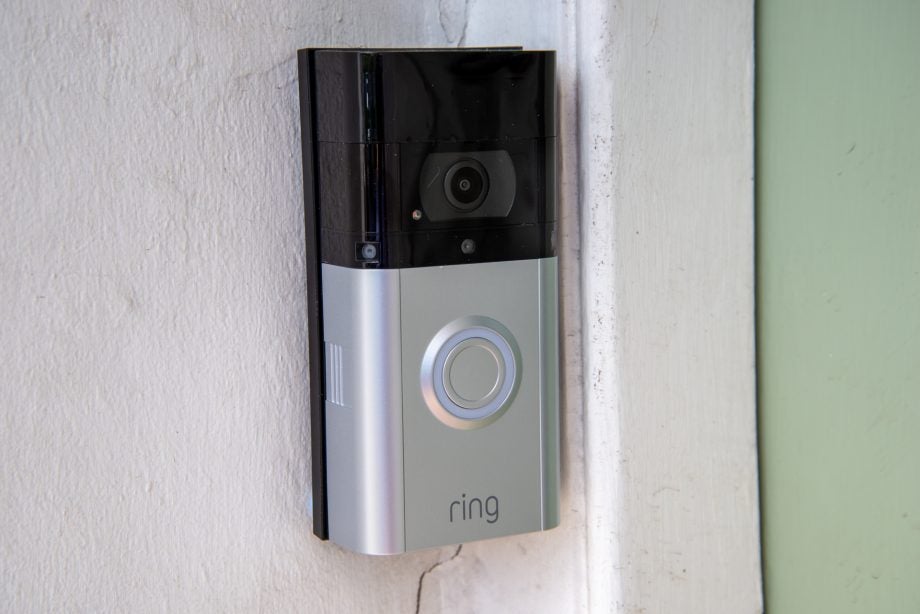
Verdict
The Ring Video Doorbell 3 Plus comes with clever pre-roll technology, allowing you to get a better sense of what caused an event to happen. In addition, it comes with greater control over motion alerts, which successfully reduces the number of alerts you receive. However, with the same resolution and viewing angle as its predecessor, there isn't much reason to upgrade; but for everyone else, this is the best battery-powered doorbell on the market.
Pros
- Powerful motion and notification control
- Clear audio and video
- Pre-roll gives you more sense of what's going on
Cons
- Timeline is fiddly to navigate
Key Specifications
- Review Price: £199
- Smart doorbell
- 128 x 62 x 28mm
- 1080p resolution
- 160-degree field of view
- Cloud recording
- IR night vision
- Battery powered
- Amazon Alexa support
Ring’s battery-powered doorbells have made smart security at the door easier, but they’ve had to strike a balance in terms of the features offered and power usage. With the Ring Video Doorbell 3 Plus, the company is back with a new model that aims to offer as close to a wired-in experience as possible, boosting motion detection and video recording so you don’t miss a moment.
It’s largely successful in its job, too; it’s certainly the best battery-powered doorbell I’ve reviewed. Yet, for all of its success, the wired Pro model is still better and there isn’t much reason to upgrade from the Ring Video Doorbell 2.
Ring Video Doorbell 3 Plus – What you need to know
- Installation – You can just attach it to a doorframe or wall, with no need for wires, although you can connect to an existing wired doorbell thermostat if you prefer
- Detection performance – Smart use of the PIR sensor helps cut down on false positives, while there’s decent notification suppressant tech to stop an overload of phone beeping
- Image quality – Same quality footage as previous models: a touch over-sharpened but plenty of detail and well-exposed video.
Related: Best security camera
Ring Video Doorbell 3 Plus build – Chunky but good-looking with interchangeable face plates
- Attractive but fairly large and obtrusive, but of good, solid construction
- Wireless and wired installation is possible
- It can connect to home wi-fi, though you’ll need a strong signal at your door
Externally, there’s little that differentiates the new model from the older Ring Video Doorbell 2. It’s still a solid and chunky bit of kit (128 x 62 x 28mm), which may prove a bit too wide to fit on some door frames. This isn’t necessarily a problem; Ring includes two wedges in the box to aid fitting. One is a corner mount, which I had to use on my door, and a second works to angle the doorbell down.
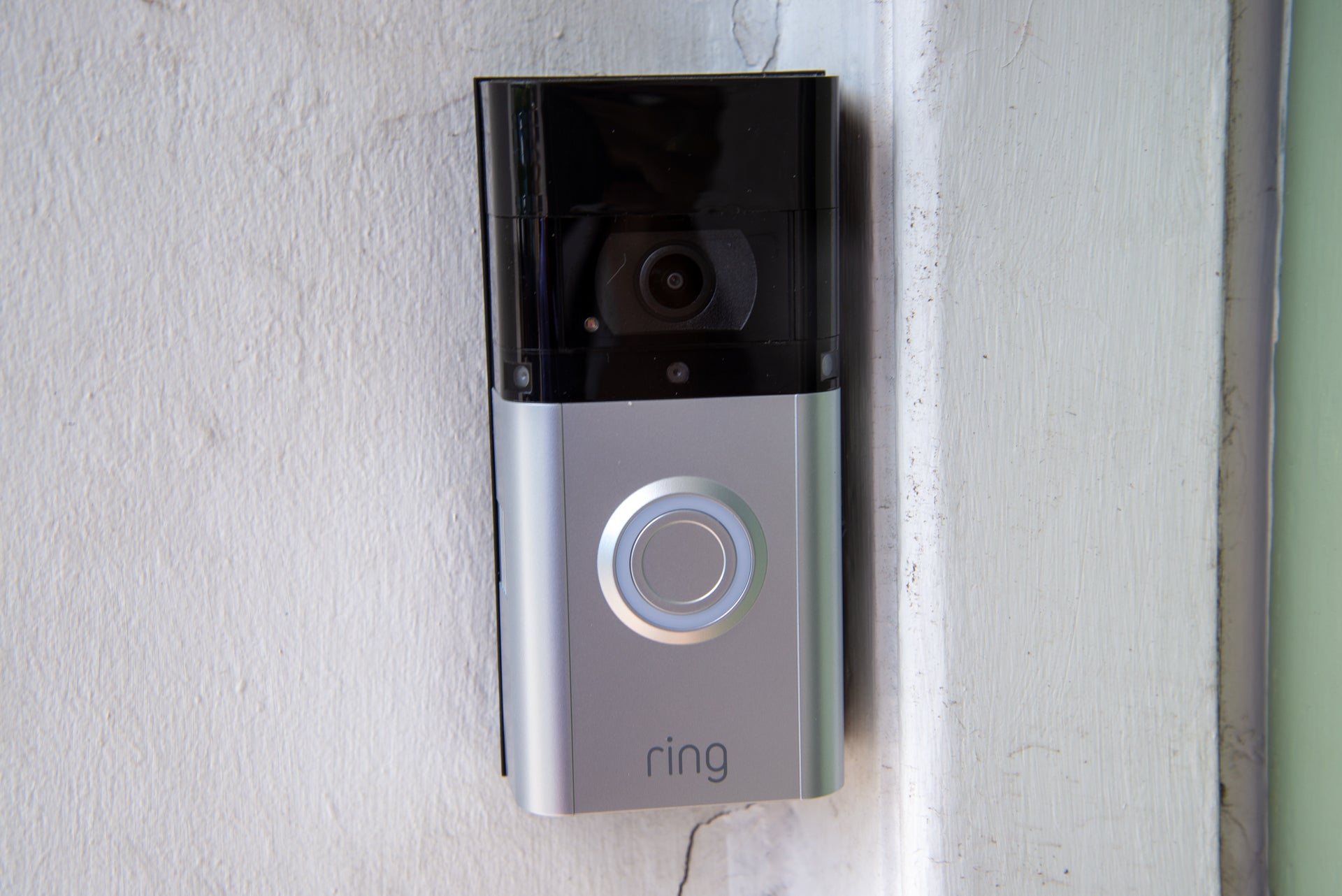
The unit is chunky, but you get some wedges in the box that should help you to fit the doorbell to most homes
Even so, the Ring Video Doorbell 3 Plus is still quite noticeable when installed. This is because the unit needs to be sufficiently roomy to accommodate a battery inside. Mains-powered devices, such as the Ring Video Doorbell Pro or the Nest Hello, are a lot slimmer. Ultimately, it’s a trade-off between convenience and size, and I have to say that you get used to the look of the doorbell once it’s been installed for a while.
It’s good to see two cover plates in the box, one silver and the other deep brown, so you can choose the one that best matches your front door.
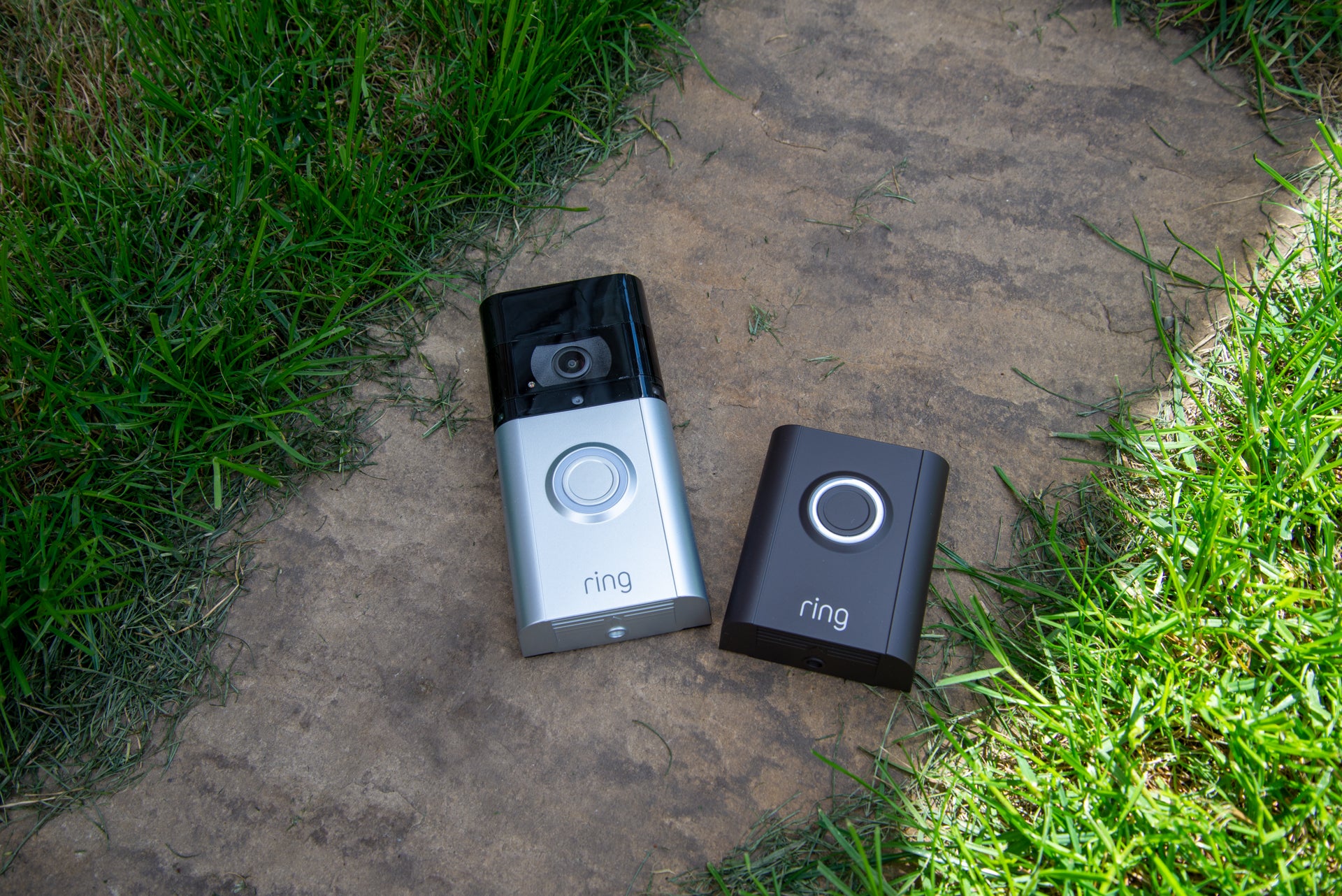
A choice of faceplates lets you adapt the doorbell to your home’s exterior
If you already have a wired doorbell, then the 3 Plus can be wired in. It still requires the battery, but the mains power automatically charges the camera and rings your internal chime when someone presses the doorbell.
For those without a wired connection, the bottom cover of the doorbell has to be removed to access the battery pack; this slides out and is charged via USB. You can buy additional batteries if you want to swap over units without any downtime.
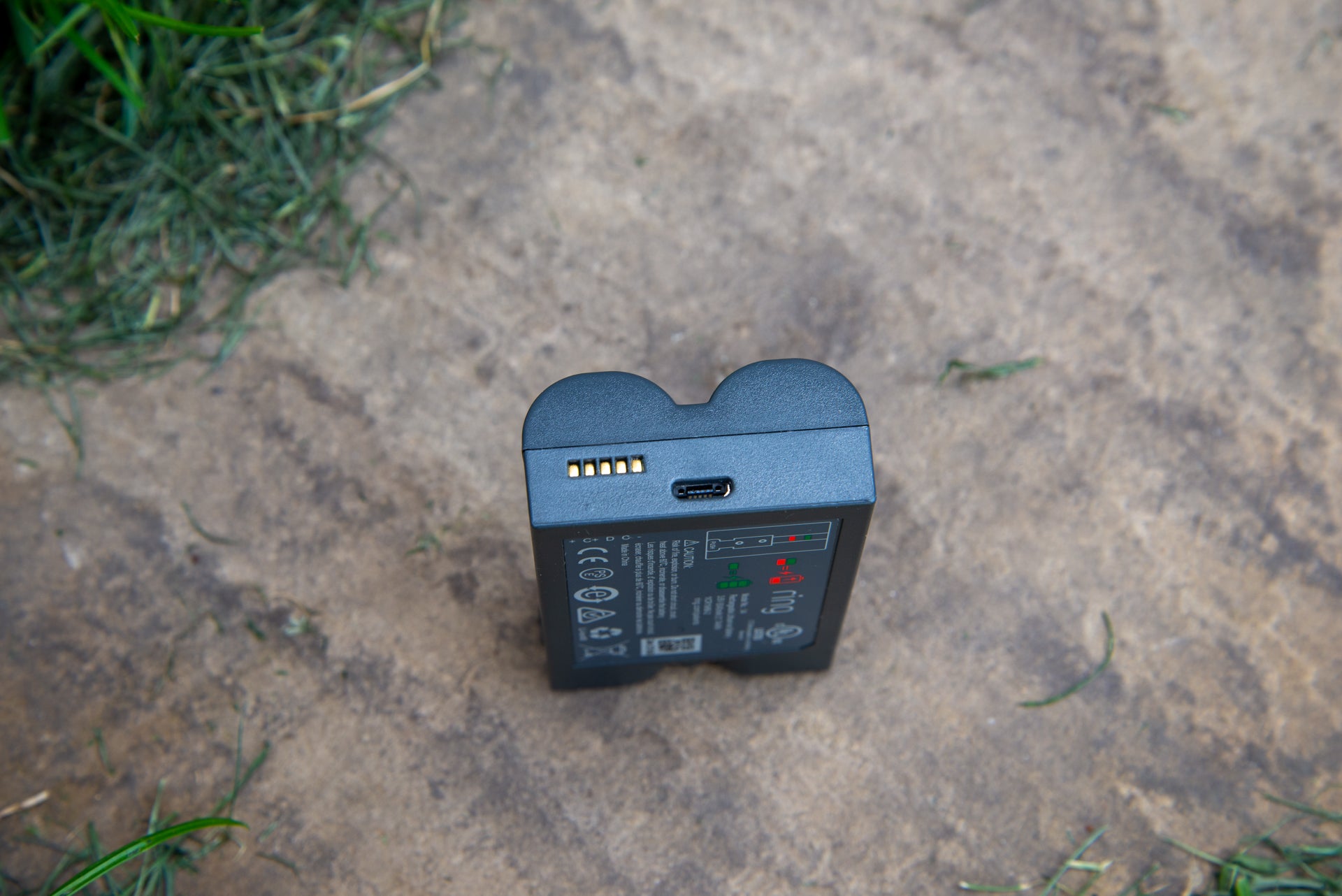
You get a rechargeable battery in the box
As with previous models, the Ring Video Doorbell 3 Plus connects to your home network via Wi-Fi. This time around, the doorbell supports 2.4GHz and 5GHz networks, although the doorbell still requires you to have a fairly strong signal at your front door.
There’s a new Chime Pro, which acts as an internal chime, a Wi-Fi extender and a night-light, if reception at your front door is poor. However, a full wireless mesh system will probably be a better choice for most people.
Ring Video Doorbell 3 Plus features – Plenty of options to increase privacy and reduce notifications
- Very accurate sensors with configurable motion detection zones to reduce bothersome notifications
- Cloud storage for recorded footage is available for a monthly subscription
- The app mostly works well, though it can be tricky to find older video clips
All battery-powered cameras rely on PIR motion sensors to detect movement. The benefit is that PIR sensors use little power, but they’re not as configurable as powered cameras, where you can set activity zones to monitor.
With the Video Doorbell 3 Plus, Ring has pushed the limits of what you can do with PIR sensors, and now has a more configurable set of motion detection zones. Using the image from the camera as a guide, there are three main zones (front, left and right), and a close-range zone for movement between five and 15 feet. Each zone can be toggled on and off, to cut down on the notifications you receive, plus you can adjust the motion sensitivity.
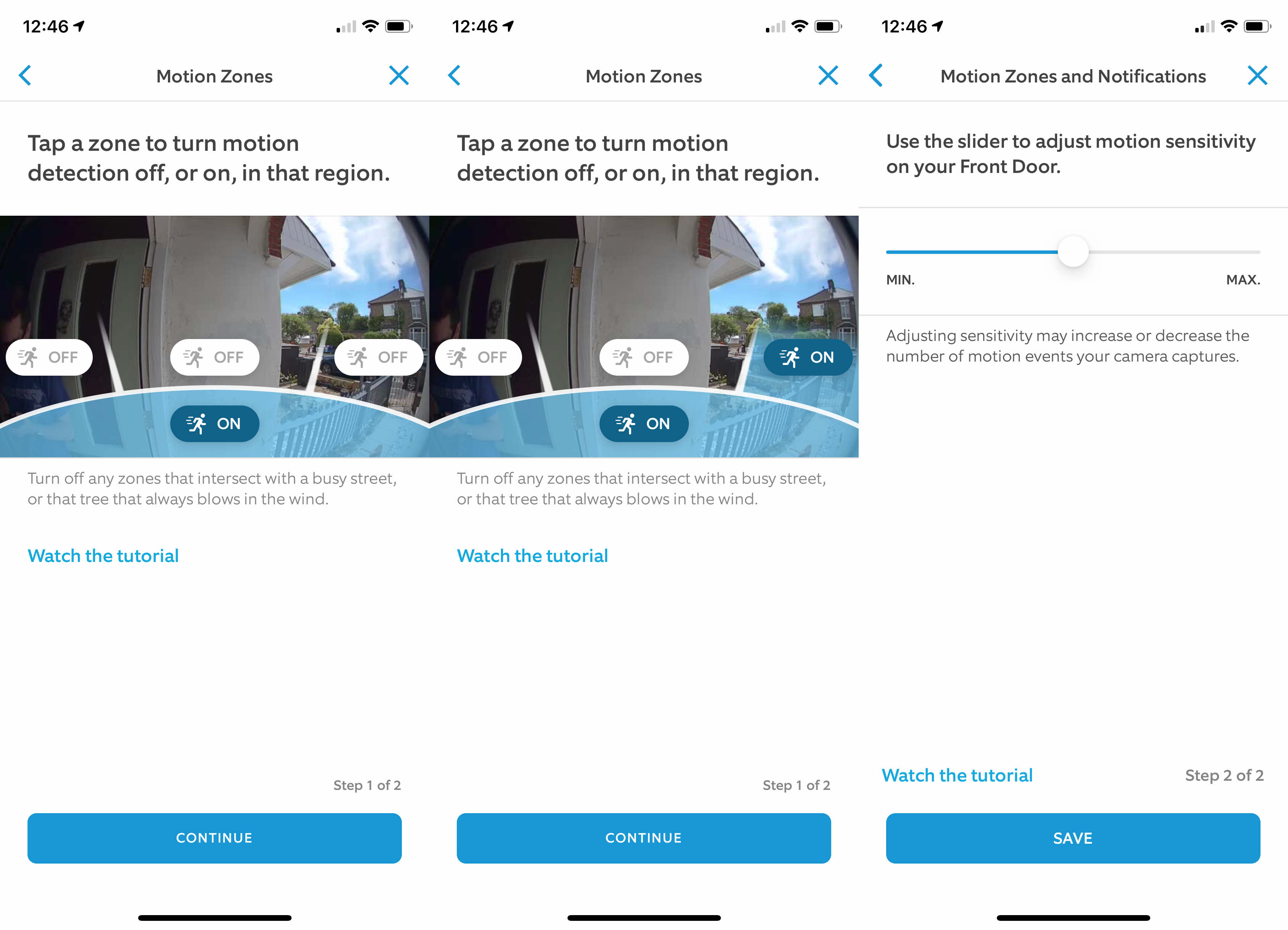
There’s decent control over the PIR sensor, although you get more granular control with devices that have activity zones
I found that the options worked pretty well, preventing the neighbours coming home from triggering the PIR sensor. However, depending on how close to the road you live (and how busy it is), you may have to disable motion detection completely. Note that cameras that let you draw activity zones are more accurate and produce far fewer notifications.
Ring has a few other options to reduce notification overload. Motion Verification trims clips if the motion stops before a recording ends. There is a People Only mode, which will notify you only if a person is detected. I found that this was pretty reliable, making only the odd mistake.
As with previous Ring products, you can also schedule when you receive motion alerts; but the camera will continue to record. You can also use modes to configure when the doorbell should have motion detection enabled: Disarmed, Home and Away. The default is that motion detection is on all of the time, which makes sense for an external device, but you can change the settings.
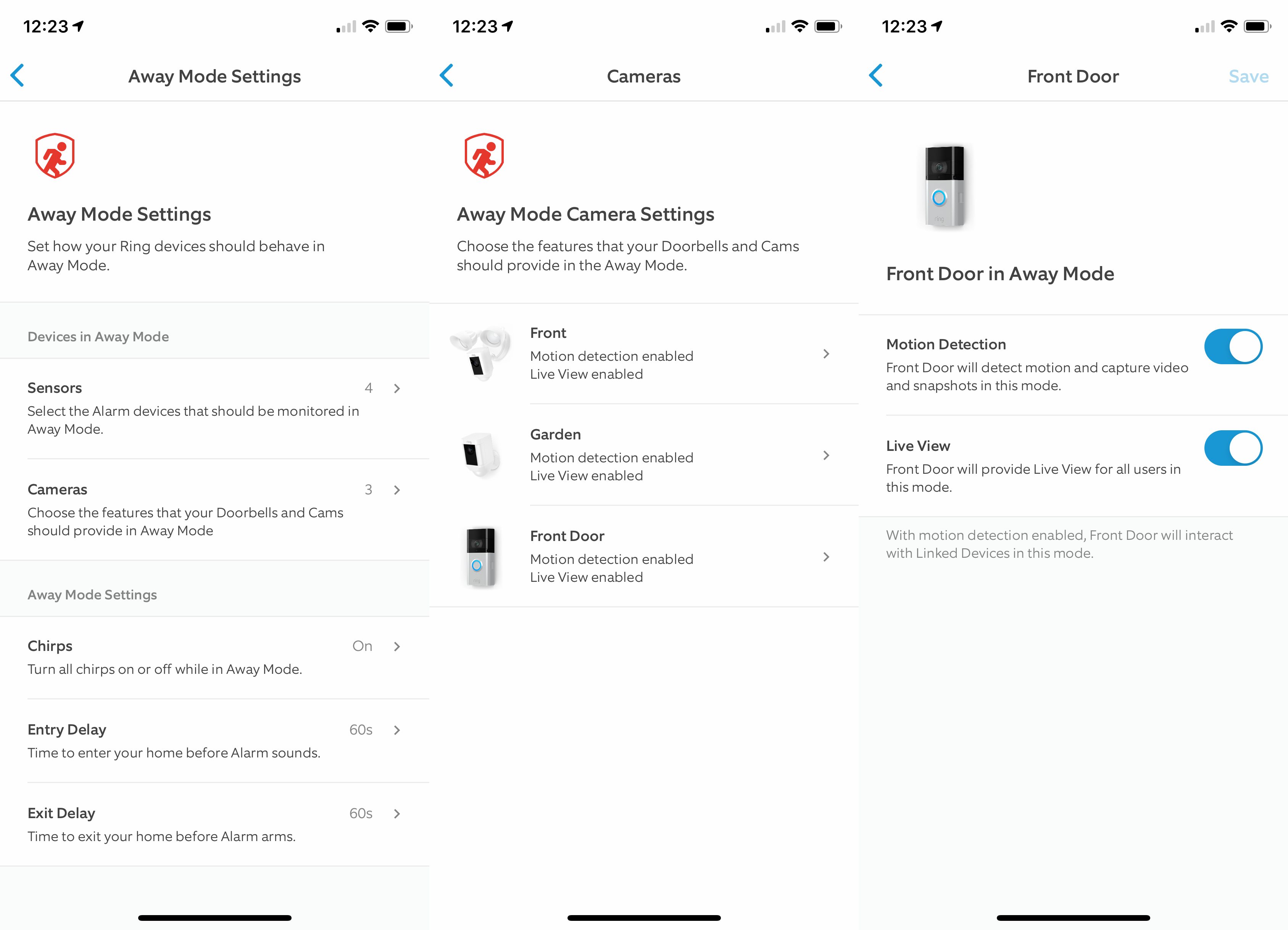
Modes tie in with the status of the Ring Alarm
Modes make more sense when you have the Ring Alarm, as changing the alarm’s state automatically changes the camera’s state to the mode you’ve set.
Finally, you can use Linked Devices to start recording on another Ring camera when your Doorbell picks up motion. It can be a handy security tool, but be careful with this setting as it’s possible to generate a lot of additional clips by mistake.
There’s the Privacy Zones feature, copied over from the Ring Door View Cam, which lets you black out parts of the video feed to protect a neighbour’s privacy. It’s handled in-camera, although the motion sensor doesn’t pay attention to these zones, so you can end up with clips where all the motion is hidden by a Privacy Zone.
Video is recorded to the cloud, provided you have a Ring Protect account. This costs £2.50 a month (£24.99 per year) per camera or doorbell for 30-day video history. Upgrade to Ring Plus (£8 a month or £80 a year), and you get 30-day history for all cameras, plus cellular backup and assisted monitoring for your alarm system.
Video clips are triggered by motion, by a doorbell press or by entering live view via the app. With the latter, you can trigger two-way talk with anyone you see on the feed, too.
A timeline allows you to scroll through video clips, and you can filter this by event type: person detected, ring, motion, live view or clips marked as favourite. You can also jump to a specific date. As useful as this functionality is, scrolling back through a day’s worth of events to find the one you want is a bit of a chore.
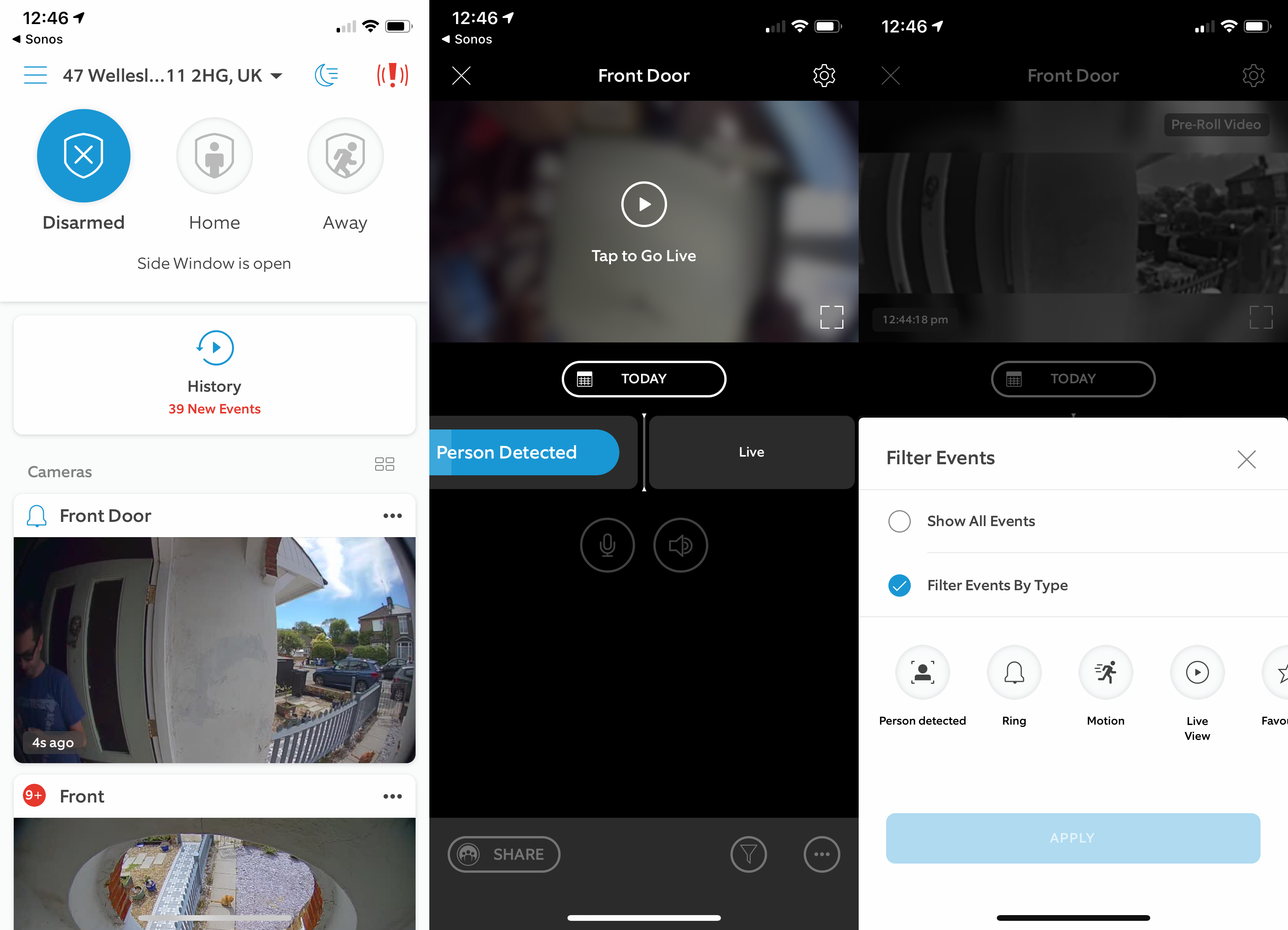
The Timeline view is still a little clunky to navigate
A secondary video history screen has the same filter options (bar date), but presents clips in a simple list. This would improve navigation, but there are no thumbnails to make the job easier. Finding old clips is still the one area that Ring needs to work on.
When you find a clip, you can tap it to play. You’ll notice a new feature straight away: pre-roll. Now, the doorbell can capture four seconds of low-resolution black-and-white video, and append it to the final clip. It’s enough to see what happened before the main event, and what triggered your doorbell.
Along with Snapshot capture, which takes a still image every 14 minutes by default (you can lower this to hourly) to fill in the blanks between clips, the Ring Video Doorbell 3 Plus provides a better idea of what’s going on.
Amazon Echo users can use the Ring Alexa skill to link their doorbell. When someone presses the bell, you’ll get a notification on every Echo device in your home. You can answer from any device, too, and view the video on smart displays such as the Echo Show.
There’s no Google Home skill, although you can add the Ring skill to the Google Assistant – although this only lets you start a new recording, get a health update or review the last Ring notification.
Ring Video Doorbell 3 Plus performance and quality – Sharp and detailed 1080p footage
- Its less intrusive thanks to fewer spam notifications
- Depending on the connected devices you’re using, the notifications may arrive 30 seconds afterwards
- Generally good quality video with a wide angle, though night-time footage can be trickier to make out
I found that the Ring Video Doorbell 3 Plus was far less intrusive than previous models in the range, delivering fewer notifications. There are limitations to what you can do with a PIR sensor, and I received more notifications than when using a wired doorbell with activity zones.
How quickly ring notifications come through depends on the type of device you’re using and network performance. I found that Doorbell 3 Plus sent notifications to Echo devices first and, usually within 30 seconds, to my phone second. Generally, that’s enough time to answer the door, although some couriers are keen to run away faster than this.
Call and video performance are as good on this device as on other Ring products: clean audio, and it’s clear to see who you’re talking to.
As a video camera, the Ring Video Doorbell 3 Plus shoots at a 1080p resolution with a 160-degree viewing angle. There are wider-angle video cameras out there, but the Video Doorbell 3’s picture is sufficient to clearly see what’s going on at your front door, and it captured enough of my front garden.
I found that I had to turn on HDR in the settings to get the best video quality, as I get the sun at the front of the house; without HDR on, the bright light could blow out some parts of the image.
During the day, the black-and-white pre-roll footage is basic, but is still able to show you what happened prior to motion being triggered. At night, it’s hard to work out what’s going on.
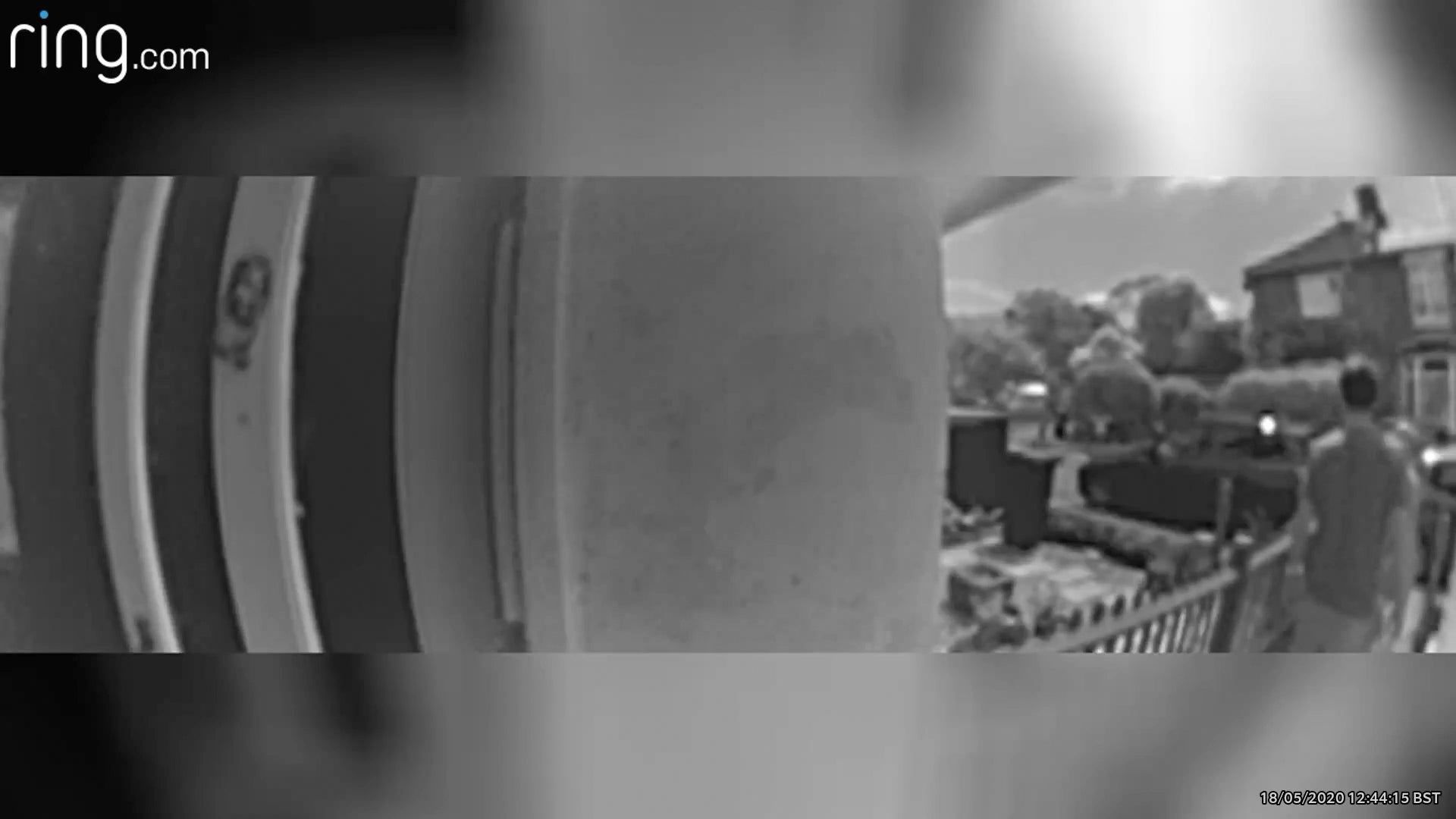
Pre-roll gives you a sense of what happened before an event but you don’t get a lot of detail
During the day, when the full 1080p camera kicks in, you get detailed footage that’s well exposed. There’s a hint of over-sharpening, but there’s enough detail to easily identify individuals.
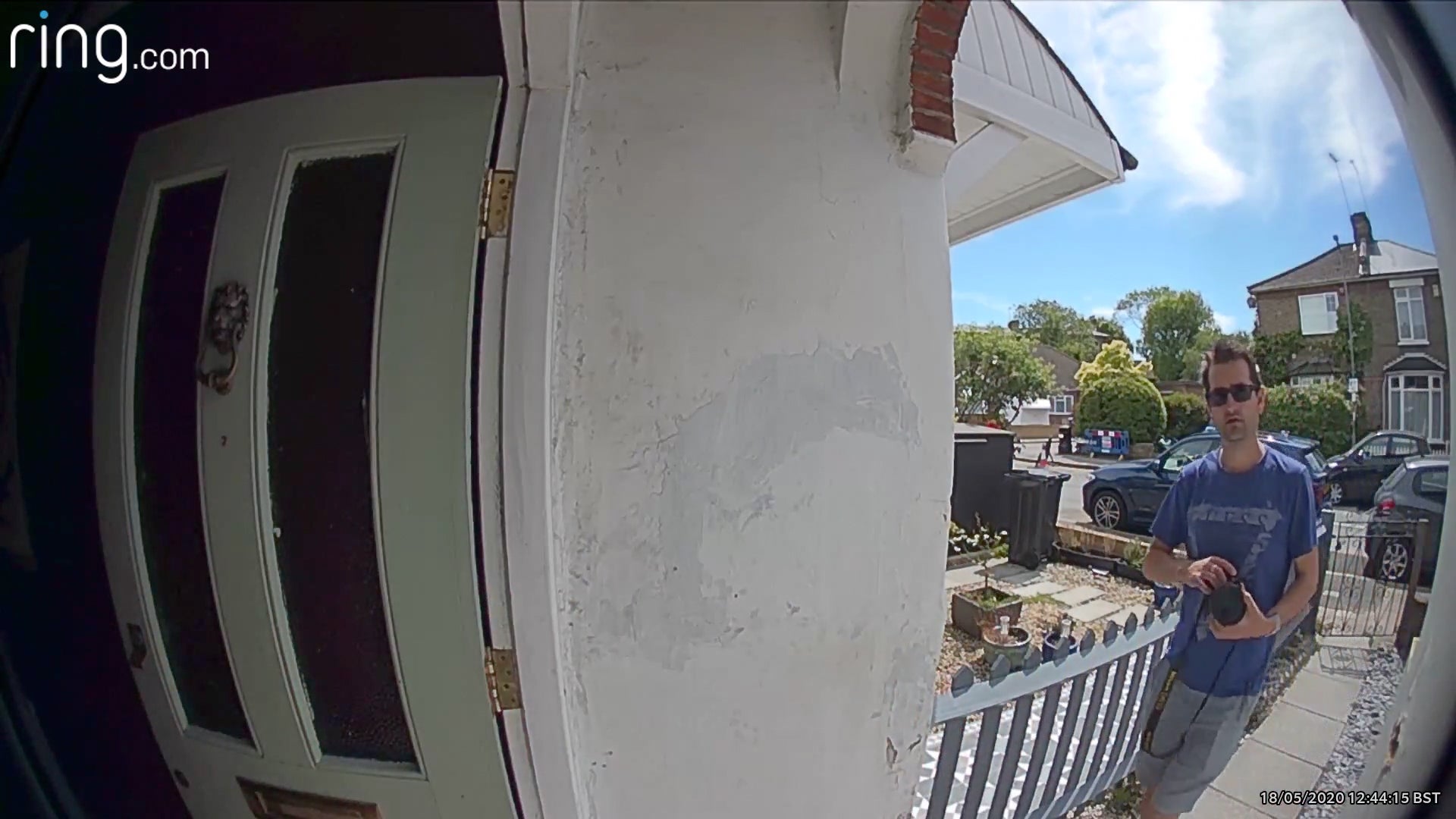
Daytime footage presents plenty of detail, although it looks a little over sharpened
At night, the doorbell switches to IR mode. Footage becomes a lot softer and details are lost in the process, so it can be harder to spot individual facial features; however, you can still tell individuals apart at a distance. Footage improves close up, when someone is talking to you, and you can see more detail.
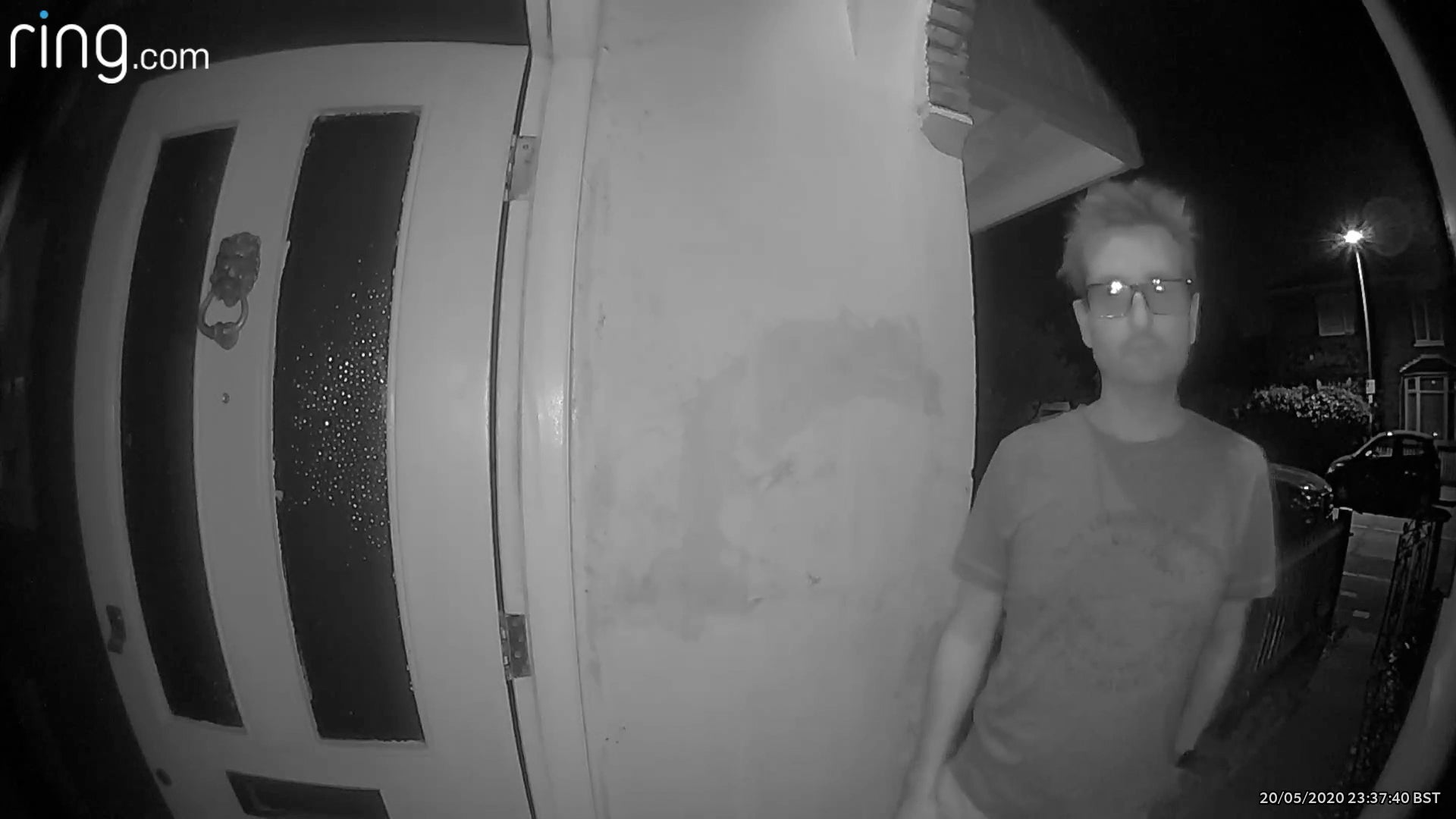
At night, IR lights let you see what’s going on but you miss out on some detail
Battery life is set to last around six months, and after running the doorbell for a couple of weeks, I’d say that estimate is about right. How often you charge will depend on the number of events you have. If you notice battery life declining fast, check your motion and detection settings to see if you can reduce the number of notifications.
Ring Video Doorbell 3 Plus Conclusion
Ring has managed to push battery-powered doorbell performance and features to the maximum with this model. Although low resolution, the pre-roll footage provides you with a greater sense of what’s going on in the seconds before an event, while the PIR, motion sensitivity and notification controls dramatically cut down on notifications.
If you already have a Ring Video Doorbell 2 then there’ isn’t enough here to warrant an upgrade. And for those wanting to buy a Ring Doorbell, plus additional cameras, and who have the ability to opt for a wired-in model, I prefer the Ring Video Doorbell Pro. If you’re not tied into Ring, then the Nest Hello is an excellent alternative.
However, for those in the market for a battery-powered doorbell, the Ring Video Doorbell 3 Plus is the best you can get, and well worth the £20 extra over the standard “3” model that doesn’t offer pre-roll footage.


